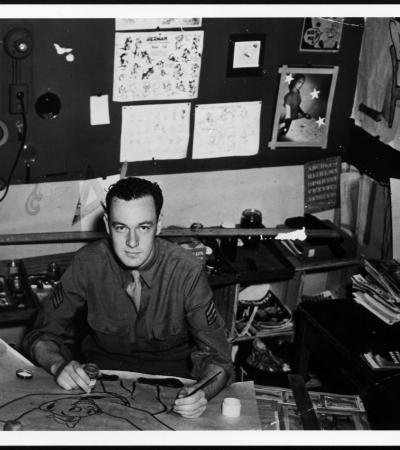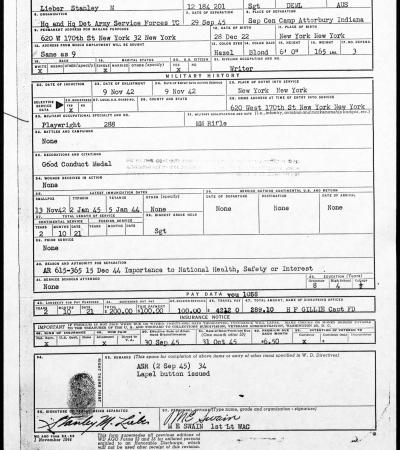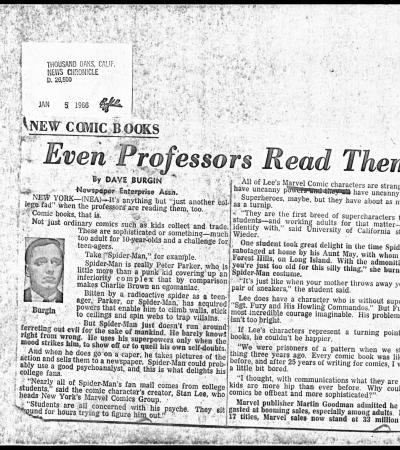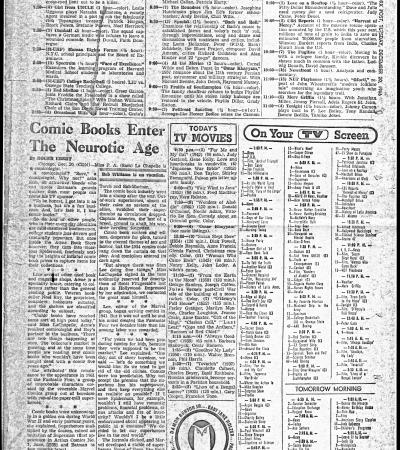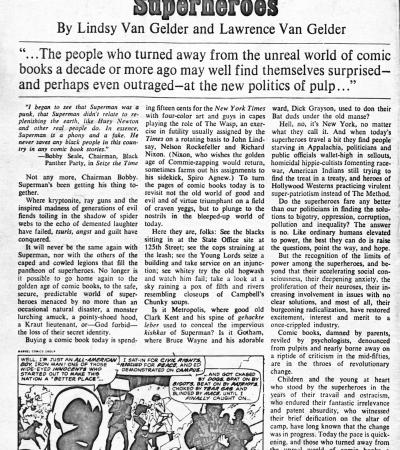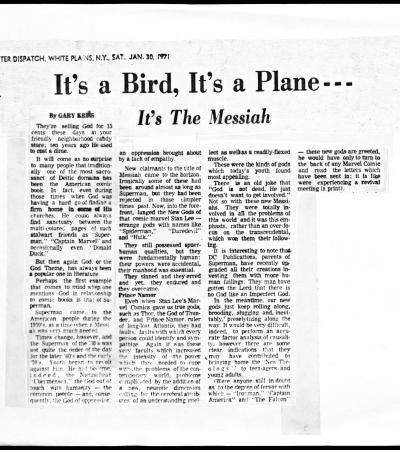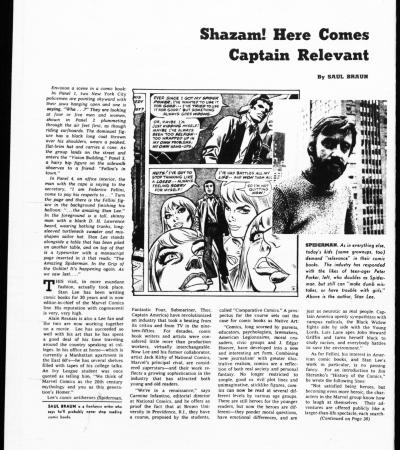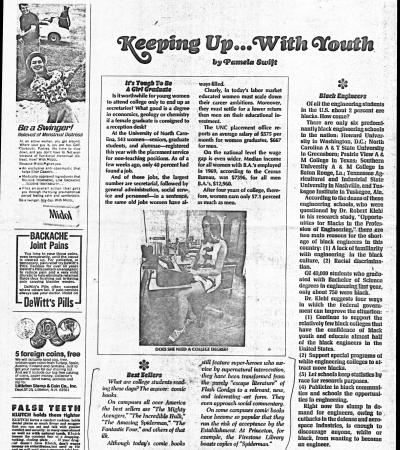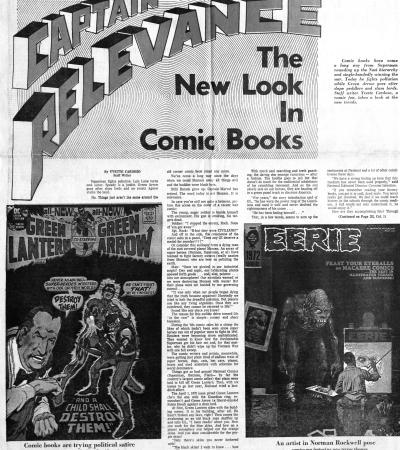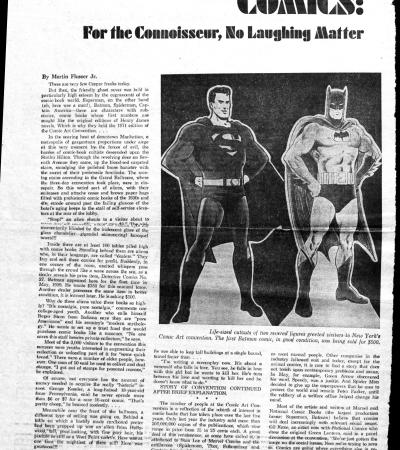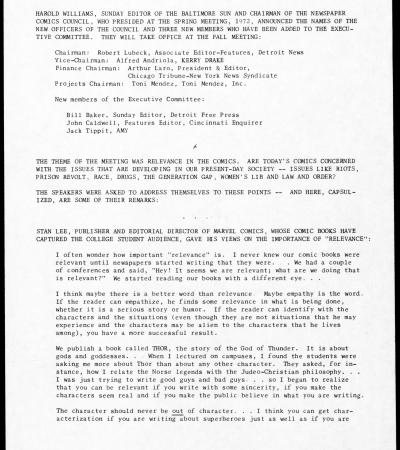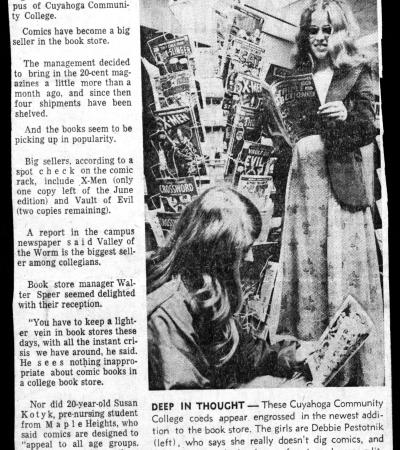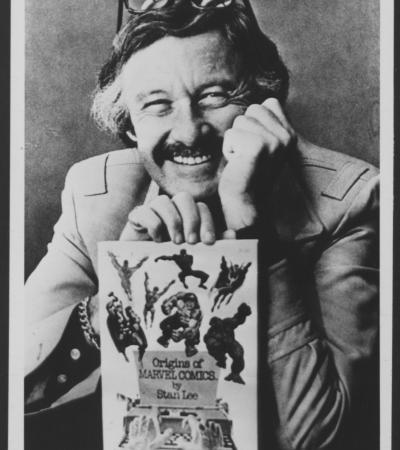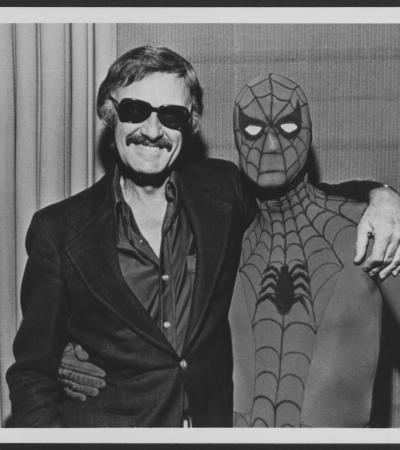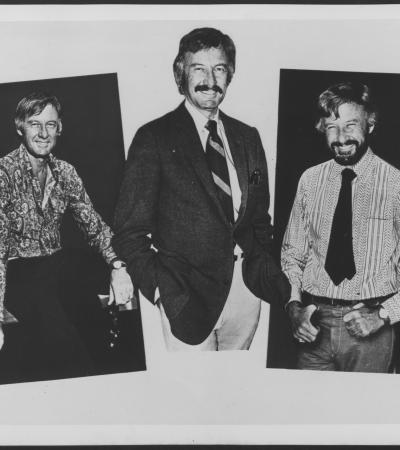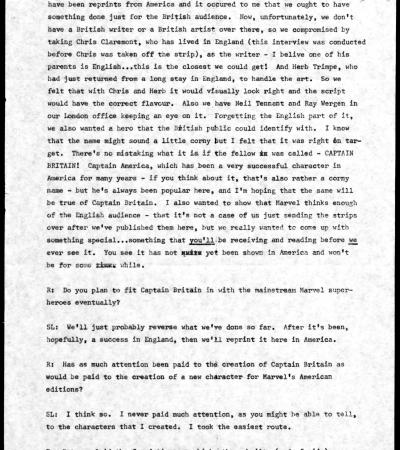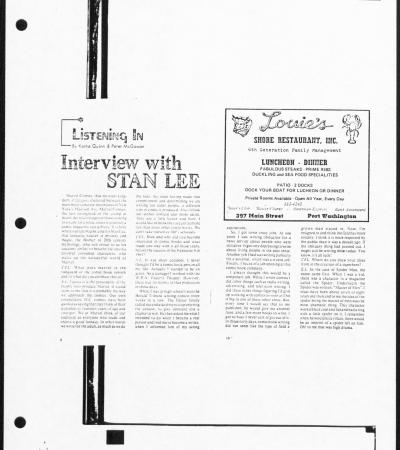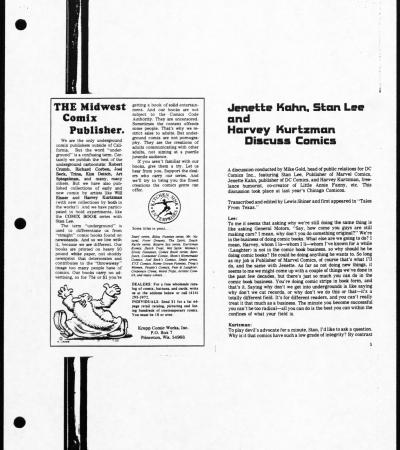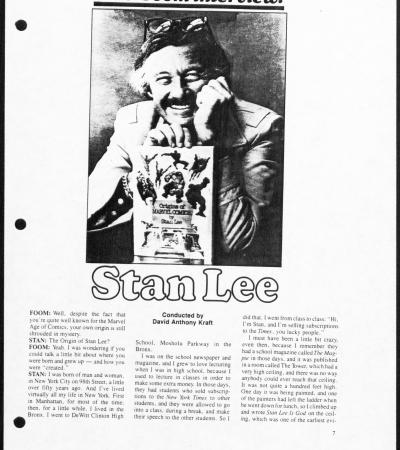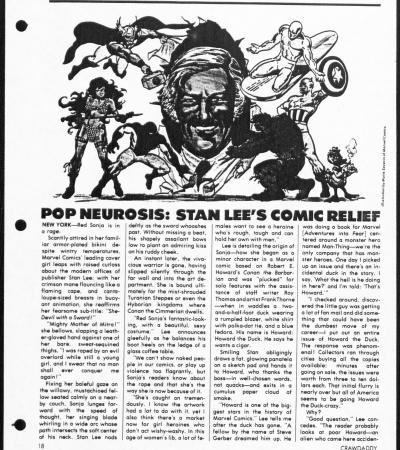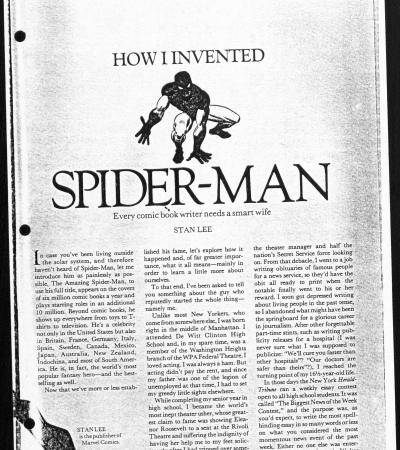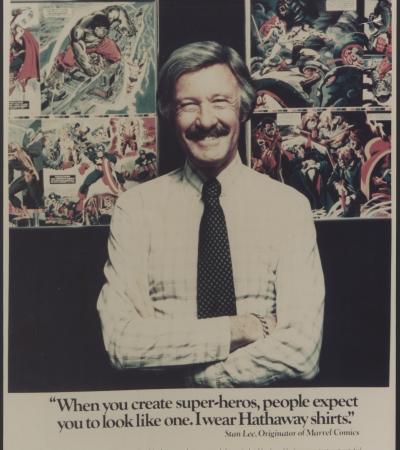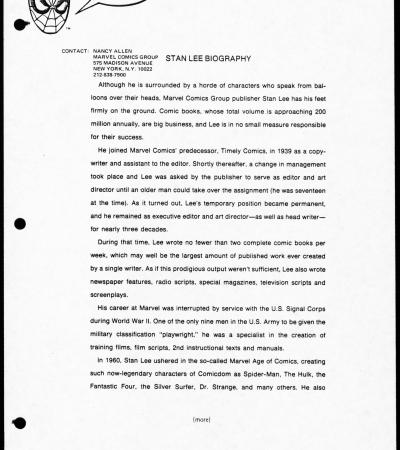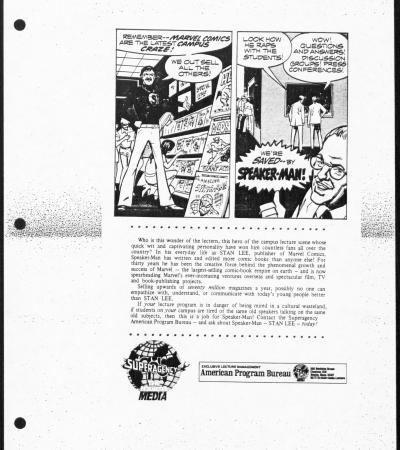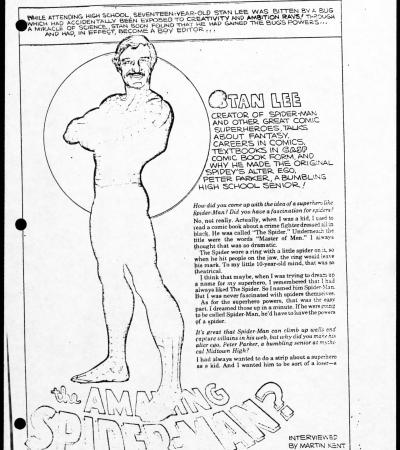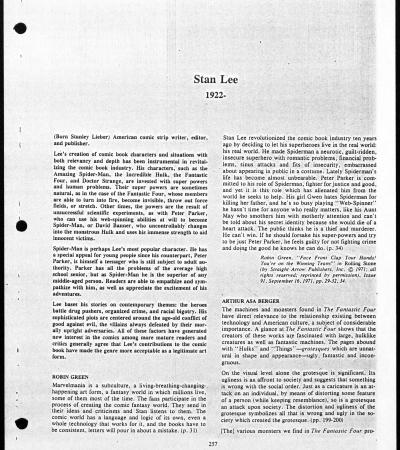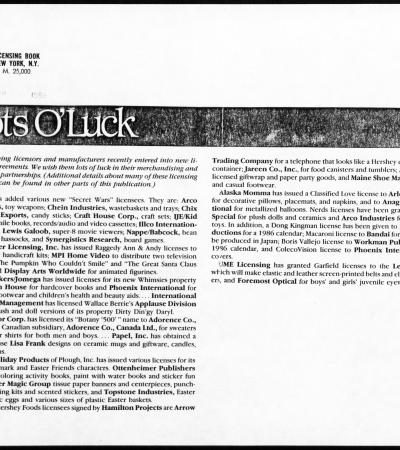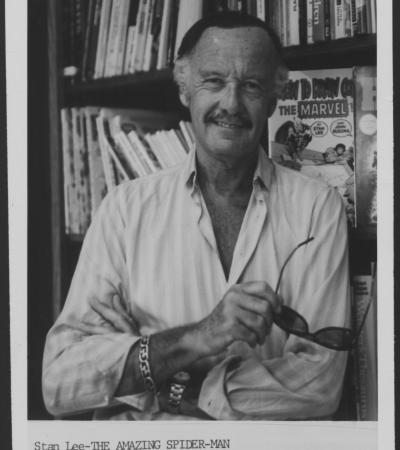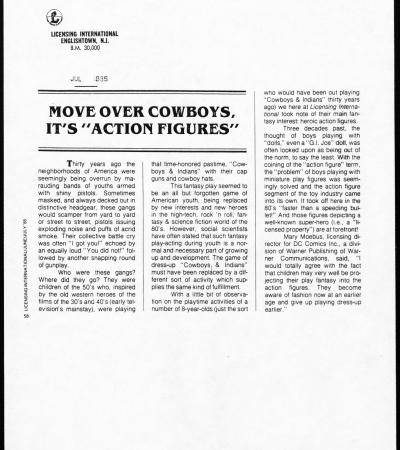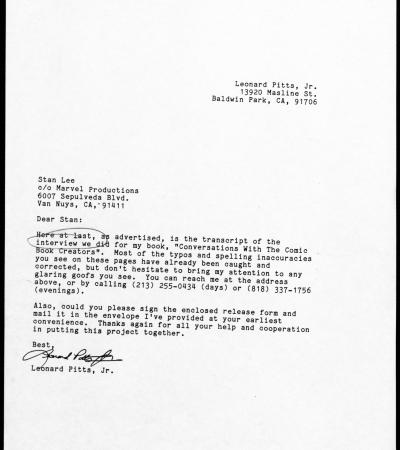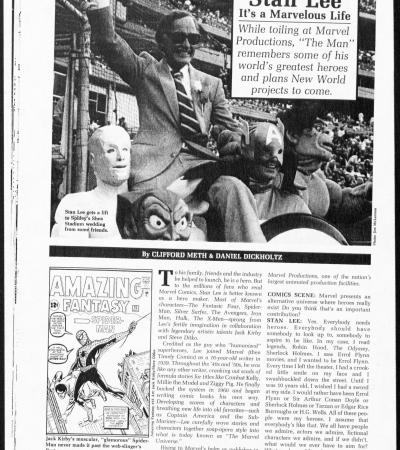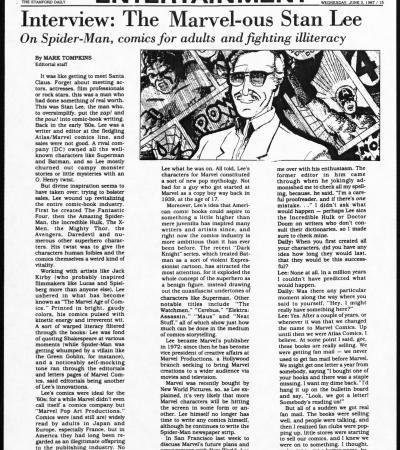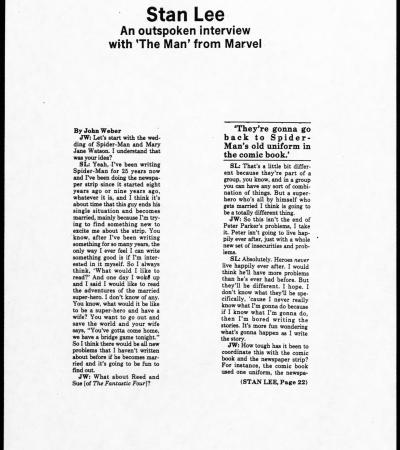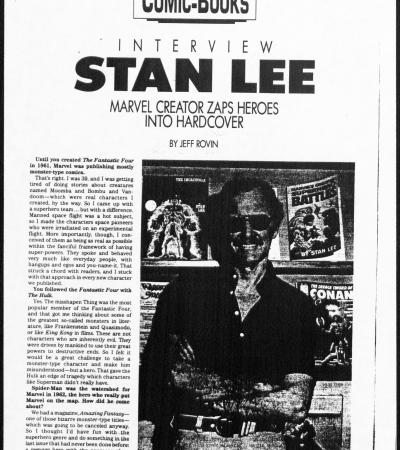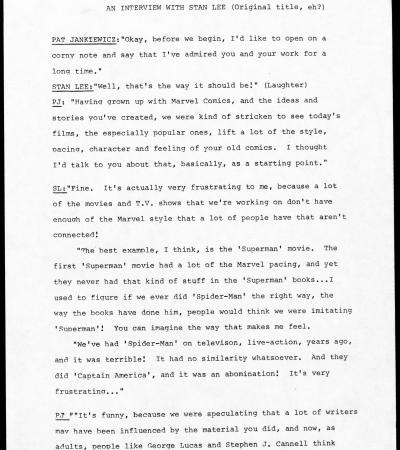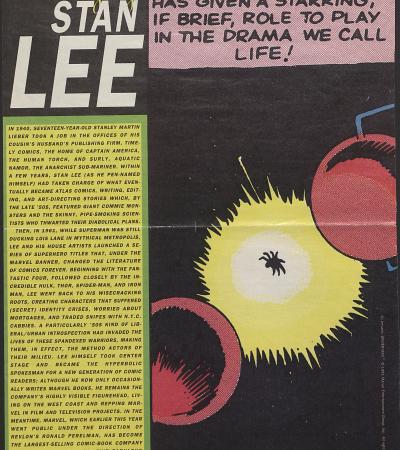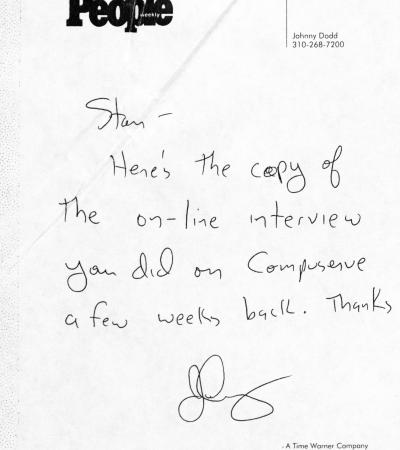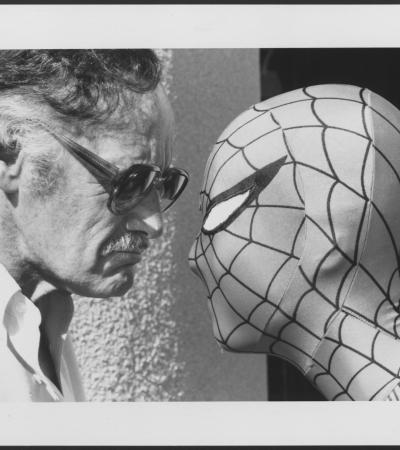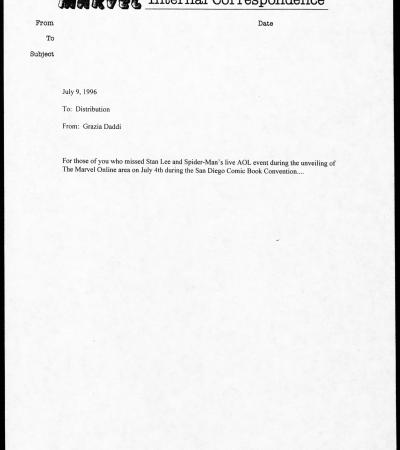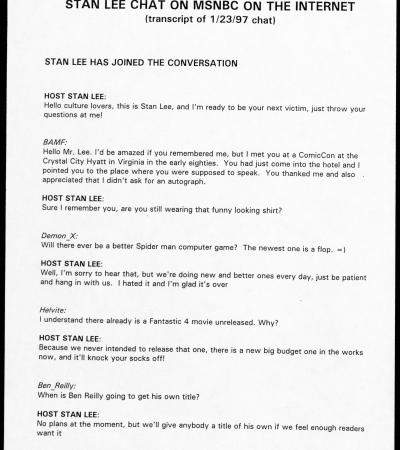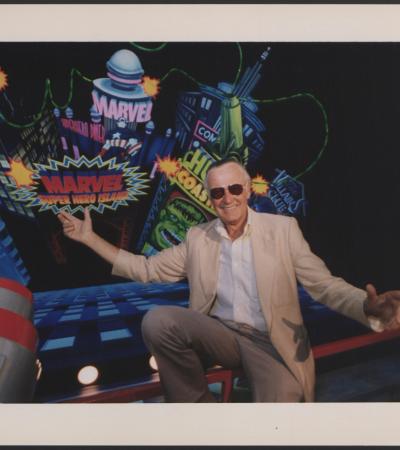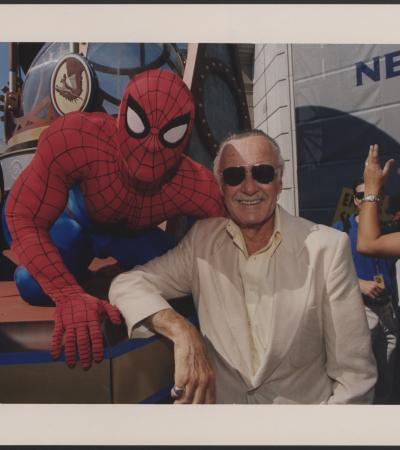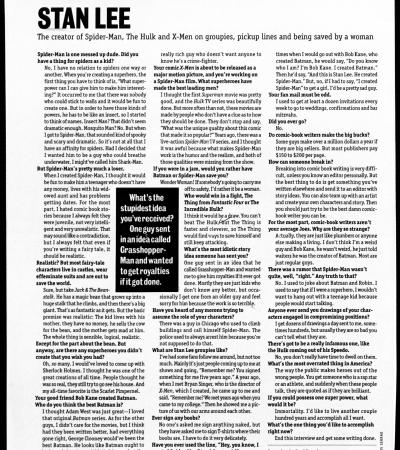The Stan Lee papers contain manuscripts and drafts of Marvel Comics productions including Spider-Man, X-Men, Captain America, Fantastic Four, and Incredible Hulk. The collection includes fan mail, business correspondence about Marvel Comics operations, magazine articles, professional files, and audio-visual materials featuring Lee's interviews, presentations, conventions, and talk show appearances. Some Stan Lee Media materials are also included.
Additional content for this collection can be found in the "Inventory for collection."
Stan Lee working on cartoon as member of the Army's Training Film Division
After the Pearl Harbor attack, Lee enlisted in the Army. Initially assisted to the Signal Corps, he was transferred to the Training Film Division when the Army learned of his artistic abilities. He created manuals, training films, slogans, and cartoons such as what he is drawing in this photograph.
Honorable Discharge documentation for Stanley Lieber
Lee served in the Army from 1942 to 1945. He was honorably discharged with a medal for good conduct. Notice his classification as "Playwright." He was one of the few in the Army with this designation. His Army experience honed his craft. He not only learned to create content quickly, but also developed skills in managing creative teams efficiently.
Stan Lee family home movies, 1940s to 1950s
Stanley Lieber married Joan Boocock, originally from Newcastle, England, on December 5, 1947, after a two week whirlwind romance. Daughter Joan Celia "J. C." was born in 1950. They lived in Long Island, New York, until moving to West Hollywood, California, in 1981. The home movie showing J.C. as a child as well as Joan and Stan runs 1 hour, 45 minutes.
More Stan Lee family home movies, 1940s and 1950s.
The Lees documented their married life and experiences as parents to J.C., capturing both family milestones and everyday moments in these home movies. The footage runs 1 hour, 21 minutes.
“Even Professors Read Them.” News Chronicle (Thousand Oaks, Calif.), January 5, 1966
This article notes the new sophistication of comic books using the complex character of Spider-Man as an example. Stan Lee explains that nearly all of Spider-Man's fan mail comes from college students, who try to figure out the character's psyche. A college student quoted in the story states that Marvel Comics has created "the first breed of supercharacters that college students--and working adults for that matter--can really identify with."
Stan Lee narrates animated Captain America television show, ca. 1966
Stan Lee, then editor of Marvel Comics, narrates a video regarding the viability of top Marvel Comics characters for television. The first Marvel characters portrayed on television used panels from the comics with the same style of illustrations—the reasoning being that if it worked for the books, it should work for the shows. And it did. The transition to different forms of media from comic books made Marvel Comics even more successful. The video runs 9 minutes, 39 seconds.
"Comic Books Enter The Neurotic Age." Roger Ebert, New York Post, December 20, 1966
Then a budding film critic, Roger Ebert writes of the progression of comics from children's pastime into adult fixation, focusing on the innovations of Stan Lee and the Marvel Group.
"The Radicalization of the Super Heroes." Lindsy and Lawrence Van Gelder, The New Yorker, Vol. 3, No. 42 (October 19, 1970)
The authors explain how the new era of publications by Stan Lee and Marvel Comics changed many people's thoughts about the fictional worlds created in the medium. By stretching the imagination, taking over the industry, and reaching audiences that had no previous interest, Marvel changed the art form forever.
It's a Bird, It's a Plane... It's The Messiah," The Reporter Dispatch, January 30, 1971
This newspaper article by Gary Krebs from The Reporter Dispatch (White Plains, N.Y.) examines the cultural phenomenon of comic book superheroes and their quasi-religious appeal to readers. TThe piece discusses how characters like Superman, Spider-Man, and others from Marvel and DC Comics have become modern mythological figures, comparing them to ancient gods while noting their human flaws. The article explores how these comic book heroes have captured the American imagination and represent a form of contemporary mythology in popular culture.
"Shazam! Here Comes Captain Relevant." Saul Braun, The New York Times Magazine, May 2, 1971
An article examining the cultural evolution of comic books from simple entertainment to sophisticated social commentary. The piece explores how comics have gained acceptance among college students and adult readers, using examples like Spider-Man and other Marvel characters. It discusses the industry's growth, the cultural significance of superheroes as modern mythology, and how creators like Stan Lee revolutionized the medium by creating psychologically complex characters that readers can relate to.
"Keeping Up…With Youth." Pamela Swift, Parade, August 1, 1971
College students were now engaging in comic book culture. Comics had become so widely read and accepted that they were even collected by the library at Princeton.
"Captain Relevance: The New Look in Comic Books" Fort Lauderdale News and Sun-Sentinel, August 29, 1971
This article by Yvette Cardozo examines how comic books have evolved from children's entertainment to sophisticated social commentary. The piece explores comics' growing cultural legitimacy and adult readership, highlighting examples like Green Lantern and Green Arrow that tackle contemporary political and social issues, demonstrating the medium's shift toward more mature, relevant content.
"Comics: For the Connoisseur, No Laughing Matter." Martin Flusser Jr., Newsday, September 15, 1971
Examines the growing sophistication and cultural acceptance of comic books, focusing on comic collecting and conventions. The piece explores how comics have evolved beyond children's entertainment to become serious collectibles and art forms, highlighting the dedicated fan culture surrounding vintage comics and the emergence of comic conventions as significant cultural events. It discusses the market for rare comics and the passionate community of collectors and enthusiasts who treat comics as legitimate cultural artifacts worthy of preservation and study.
Stan Lee speaking at a college campus around 1971.
Stan Lee was a well-known speaker who appeared across various media platforms. Because he did not truly enjoy giving speeches, he often structured his appearances as question-and-answer sessions, making them more casual and interactive. Through these appearances and speeches, public awareness of Marvel Comics and Stan Lee grew exponentially. The Marvel comics, with Stan Lee as their primary spokesperson, attracted a large college audience, and he frequently spoke on campuses, inspiring students with his presentations. The footage runs 44 minutes.
Transcript of remarks from the Spring 1972 meeting of the Newspaper Comics Council
Following Frederic Wertham's The Seduction of the Innocent (1954), which claimed comics negatively influenced young people, the Comics Code Authority and Newspaper Comics Council were created to monitor comic content. At this meeting, industry professionals including Stan Lee (Marvel Comics), Raymond K. Rogers (King Features Syndicate), William Attwood (Newsday), Ted Shearer (Quincy), and others addressed the relevance of comics to contemporary social issues.
"Comics sell with textbooks on college bookstore racks." Bud Weidenthal, The Cleveland Press, March 10, 1973
This article reports on the growing popularity of comic books among college students at a local community college. The piece describes how comics have become bestsellers in the college bookstore alongside textbooks, featuring interviews with students and staff about the appeal of titles like X-Men to college-age readers who grew up with comics and continue enjoying them.
WNBC-TV Segment about Marvel Comics Group, 1973.
News story examining how Marvel Comics incorporated anti-drug messaging into their publications following a 1971 government request. The U.S. Department of Health, Education and Welfare approached Marvel, then under Stan Lee's editorial leadership, asking the company to address drug themes in their popular comics. Marvel responded with a three-part story arc in The Amazing Spider-Man issues 96 through 98. The segment runs 3 minutes, 25 seconds.
Stan Lee with "Origins of Marvel Comics" (1974)
Stan Lee poses with a copy of Origins of Marvel Comics, the 1974 trade paperback collection that featured origin stories and selected adventures of Marvel's most popular characters including The Fantastic Four, Spider-Man, Thor, The Hulk, and Doctor Strange. This book, published by Marvel Fireside Books, was Marvel's first trade paperback collection and helped introduce the company's characters to a broader audience beyond regular comic book readers.
Stan Lee interview, "Straight Talk," WWOR-TV (New York City), 1974.
In this interview, Stan Lee discusses how comic books serve as modern fairytales that provide escapism for readers of all ages. He explains how comics fill the void left when childhood stories no longer captivate us, and describes how comic book conventions have emerged as gathering places for older readers to connect over their shared interests. Lee also addresses why Marvel's superheroes resonate with audiences—despite their extraordinary powers, they face relatable, everyday human problems that readers can identify with. The segment runs 17 minutes.
Stan Lee with Spider-Man, ca. 1975
This image reflects the growing cultural presence of Marvel superheroes during the mid-1970s, when characters like Spider-Man were expanding beyond comic books into television, merchandise, and public appearances. This period marked increasing mainstream recognition for Stan Lee as the public face of Marvel Comics and its stable of iconic characters.
Interview with Stan Lee by his daughter J.C. Lee, ca. 1975.
J.C. introduces Stan Lee as the creator and publisher of Marvel Comics, highlighting his popularity as a college lecturer and media personality. The interview covers Lee's career spanning more than 30 years, his prolific writing output (formerly writing multiple comic books weekly), and his transition to publisher role. They discuss his connections with celebrities like Federico Fellini and Paul McCartney, his Origins of Marvel Comics book series, and the challenges of gaining recognition in traditional literary circles despite strong sales figures.
Different looks of Stan Lee, 1970s
This composite image shows three promotional photographs of Stan Lee from the 1970s, each featuring him in different attire - from casual patterned shirts to a formal business suit. The varied looks demonstrate Lee's adaptability as Marvel Comics' public spokesperson, able to present himself for different audiences and occasions during his prominent role representing the company.
Footage from Marvel Comics Convention, April 23 - 25, 1976
Scenes from Marvel Comics' second annual convention at New York City's Commodore Hotel. The film includes interviews with fans and industry professionals, art demonstrations by penciler John Buscema, talks by editor-in chief Archie Goodwin, and editor/writer Roy Thomas. Footage runs 27 minutes, 35 seconds.
Stan Lee interview, Canada A.M., CTV, May 3, 1976
Stan Lee discusses his career journey from teenage assistant to Marvel Comics publisher, the evolution of superhero comics into more complex characters appealing to older readers. He also addresses Dr. Fredric Wertham's anti-comics campaign, defends comics as valuable reading aids, and discusses Marvel's educational initiatives. He also promotes upcoming Marvel character appearances at Canadian venues, highlighting the company's expansion beyond traditional publishing. Segment is 10 minutes, 30 seconds.
Transcript of Stan Lee interview about Captain Britain, September 8, 1976
Stan Lee discusses Marvel's creation of Captain Britain for the British market. Lee explains the challenges of developing content specifically for British audiences, including finding appropriate creative staff and balancing American and British sensibilities. The interview covers Marvel's expansion into international markets, Lee's role as Marvel's public spokesperson, his extensive college lecture circuit, and his philosophy about comic fandom.
Stan Lee interview, Celebrate Magazine, December 1976
This magazine interview, titled "Listening In" and conducted by Katha Quinn & Peter McGowan, features Stan Lee discussing Marvel Comics' evolution and future plans. Lee talks about the company's expansion beyond traditional comic books into new formats and media, including educational projects, television workshops, and book publishing. He discusses Marvel's approach to creating new characters, the success of characters like Spider-Man and Silver Surfer, and the growing acceptance of comics as a legitimate art form.
"Jenette Kahn, Stan Lee and Harvey Kurtzman Discuss Comics" panel discussion
A transcript documenting a panel discussion conducted by Mike Gold, head of public relations for DC Comics, at the 1976 Chicago Comicon. The panel featured Stan Lee (Marvel Comics), Jenette Kahn (DC Comics), and Harvey Kurtzman (co-creator of Little Annie Fanny). The conversation covers the comic book industry's challenges including production costs, artistic integrity versus commercial demands, the rise of underground comics, and the tension between creative innovation and market pressures.
"The FOOM Interview: Stan Lee." David Anthony Kraft, FOOM, Vol. 1, No. 17 (March 1977)
This interview from FOOM (Marvel Comics' self-produced fan magazine that ran from 1973-1978) features Stan Lee discussing his career journey from teenage assistant to Marvel publisher, starting in 1939. Lee recounts his early experiences, time with the WPA Federal Theatre, and his evolution of Marvel's approach to creating complex, relatable superheroes. The interview covers his work on various Marvel properties, the company's creative process, and expansion into television and publishing beyond traditional comics.
"Pop Neurosis: Stan Lee's Comic Relief," Crawdaddy magazine, March 1977
The piece discusses Lee's creation of complex, psychologically nuanced superheroes like Howard the Duck and Spider-Man, and examines how Marvel characters became cultural phenomena reflecting contemporary social issues. The article also covers Lee's expansion into other media and his role in legitimizing comics as a serious art form during the 1970s counterculture movement.
"How I Invented Spider-Man" by Stan Lee, Quest, July/August 1977
Lee describes his evolution from writing simple superhero stories to developing complex, relatable characters with real-world problems. He explains his philosophy of creating heroes who face everyday challenges like acne, dating, and financial troubles alongside their superhuman responsibilities. The article details how Spider-Man was developed as a teenage character who struggles with ordinary adolescent issues while fighting crime, and discusses how this approach revolutionized comics.
Stan Lee interview, Chicago PBS station WTTW, 1978.
In this PBS television segment, critic Johanna Steinmetz interviews Stan Lee, who discusses creating realistic, flawed superheroes who face everyday problems, Marvel's approach emphasizing satire over violence, and characters like Spider-Man and Silver Surfer as complex figures. Following the interview, Steinmetz discusses the comic industry's societal value with hosts John Callaway and Jim Reynold, including perspectives on comic content and impact on young readers. Footage runs about 8 minutes.
Stan Lee in Hathaway shirt advertisement, late 1970s
Stan Lee is shown in his characteristic jovial pose, surrounded by colorful comic book pages featuring Marvel characters, representing the crossover between comic book culture and mainstream advertising during Marvel's growing cultural influence in the 1970s.
Stan Lee biography press release from Marvel Comics Group, late 1970s
Marvel's press release outlines Lee's career from his 1939 start at Timely Comics through his rise to publisher in 1972. It highlights his prolific writing output, military service, and revolutionary approach to creating realistic superheroes. The biography emphasizes Marvel's global success, Lee's profitable college lecture circuit, educational projects like Spidey Super Stories, and upcoming ventures including a Spider-Man feature film.
Stan Lee "Speaker-Man" promotional flyer from American Program Bureau, mid-1970s
This promotional flyer markets Stan Lee as a college lecturer through the American Program Bureau. The text emphasizes Lee's popularity on the lecture circuit, describing him as selling "seventy million magazines a year" and positioning him as an engaging speaker who can connect with young audiences. The flyer presents Lee's campus appearances as an alternative to traditional academic speakers, capitalizing on his celebrity status and Marvel's cultural relevance during this period.
Stan Lee and J.C. Lee on "Midday with Bill Boggs," 1979
Family banter between Stan Lee and his daughter J.C. is featured as Lee explains he named his daughter after his wife to avoid remembering an extra name, while J.C. discusses pursuing an acting career. During the conversation, Lee corrects host Bill Boggs about not creating Captain America. The playful dynamic between father and daughter is evident throughout, with J.C. calling herself Lee's "greatest fan" and his "favorite character." The conversation demonstrates the family's comfort with media appearances and their shared sense of humor. Segment runs 2 minutes.
Stan Lee interview by Martin Kent, Sourcebook magazine, 1979
The interview features Lee discussing the creation of Spider-Man as a bumbling high school character to differentiate him from traditional superheroes. Lee explains Marvel's approach to creating relatable characters with real-world problems, addresses the educational value of comics, and discusses his early career writing training materials during military service. The piece explores his philosophy about comics serving as both entertainment and a literacy tool.
Stan Lee biographical entry in Contemporary Literary Criticism, Volume 17, 1981
This academic literary reference entry provides a scholarly assessment of Stan Lee's contributions to comic book literature. The piece analyzes Lee's revolutionary approach to superhero storytelling, particularly his creation of psychologically complex characters with real-world problems. Multiple critics examine Marvel characters like Spider-Man, The Fantastic Four, and others, discussing their cultural significance and literary merit.
Stan Lee television news interview with Marvel Comics staff, ca. 1982
Features Stan Lee discussing Marvel Comics alongside Marvel staff George Olshevsky, Jim Shooter, and Denys Cowan. Lee discusses the interconnected Marvel universe and rise of comics fandom and shares insights about his favorite characters (Spider-Man and Silver Surfer). The interview covers Marvel's approach to social issues, the comic creation process, and Lee's vision for the company's quality reputation. Segment runs 8 minutes, 36 seconds.
Stan Lee interview, "Thicke of the Night," January 17, 1984.
Lee appears on Alan Thicke's talk show to discuss the "comic-book revolution" and defend comics against criticism about violence. Lee argues that Marvel's comics are educational publications that encourage reading among television-obsessed children, explaining how Marvel's characters have human flaws that make them relatable to readers. He discusses Marvel's use of college-level vocabulary, his transition from writer to publisher, and his efforts to adapt Marvel properties for film and television.
Stan Lee interview, "Good Afternoon New York," June 22, 1984
This radio interview transcript features Stan Lee speaking with host Margaret Jones on WOR Radio's Good Afternoon New York program. Lee discusses his transition from Marvel Comics publisher to working on motion picture and television projects in Los Angeles, the growth of comic book fandom and conventions, and the creation of iconic characters like Spider-Man and the Hulk. He explains the origins of Spider-Man, inspired by a pulp magazine character called "The Spider," and describes the creative process behind developing Marvel's superhero roster.
Marvel Comics licensing and merchandising articles from trade publications, 1985
This collection of trade publication clippings from 1985 documents the expansion of Marvel Comics into licensing and merchandising. The articles cover various licensing agreements for Marvel characters including Secret Wars products, home video releases through Prism Entertainment, competition with DC Comics in the home video market, and promotional partnerships with companies like Dorman's cheese and General Mills cereals.
Publicity photo for "The Amazing Spider-Man" newspaper strip, 1985
A publicity photo distributed by The Register and Tribune Syndicate to promote Stan Lee's work on The Amazing Spider-Man daily newspaper comic strip. The syndicate's distribution of this promotional material indicates the commercial importance of Lee's involvement with the newspaper strip adaptation of his famous Marvel Comics character.
"Move Over Cowboys, It's 'Action Figures,'" Licensing International magazine, July 1985
This article examines the rise of action figures in the 1980s toy industry, analyzing how superhero and science fiction characters replaced traditional cowboy themes. The piece discusses licensing strategies behind popular lines like Marvel's Secret Wars, DC's Super Powers, Transformers, and G.I. Joe, while exploring the shift from Saturday morning cartoons to syndicated programming and the emergence of female action figures. It provides industry insights into how companies developed "good versus evil" marketing themes that transformed action figures into a dominant toy category.
Stan Lee interview, "Conversations With The Comic Book Creators," ca. 1980
An extensive interview in which Stan Lee reflecting on his career and creative process with interviewer Leonard Pitts Jr. for a book project titled "Conversations With The Comic Book Creators." Lee covers his early days at Timely Comics (later Marvel), the creation of major characters like the Fantastic Four, Spider-Man, and the Hulk, and his collaborative relationship with artist Jack Kirby.
Stan Lee on National College Television's "Campus America," ca. 1985
Reporter Keith Bellows interviews Lee about his comic book creations and Marvel Comics' success. Lee articulates his approach to character development and Marvel's evolution from children's entertainment to sophisticated storytelling, emphasizing comics as a legitimate art form. The segment covers Marvel's business success as America's biggest comic book publisher and Lee's upcoming film projects featuring Dr. Strange, Spider-Man, and Captain America. Segment runs 4 minutes, 48 seconds.
Stan Lee home movie filming wife Joan touring their home and yard, ca. 1985
This intimate home movie captures Stan Lee filming his wife Joan touring their Los Angeles home and gardens. Joan showcases their landscaping including rose bushes, wildflowers, and canyon views, while their dogs Pookie and Annabelle appear throughout. During filming, Joan mentions her novel The Pleasure Palace published by Dell. The casual recording provides a rare glimpse into the Lees' private domestic life during Stan's Hollywood years. Film runs 5 minutes, 41 seconds.
"Stan Lee: It's a Marvelous Life," Comics Scene magazine, 1980s
Profile of Stan Lee during his time at Marvel Productions, focusing on his transition from comics to film and television. The piece includes photographs of Lee at Shea Stadium and discusses his work developing Marvel properties for other media. The article covers Lee's reflections on creating iconic characters like Spider-Man, the Fantastic Four, and the X-Men, his collaborative relationship with Jack Kirby, and his philosophy of humanizing superheroes with real-world problems.
"Interview: The Marvel-ous Stan Lee," The Stanford Daily, June 3, 1987
Th interview covers Lee's transition from comic book writing to film and television development at Marvel Productions in Hollywood. Lee details his work on upcoming movie scripts for Dr. Strange, Spider-Man, Captain America, and the Fantastic Four, while reflecting on Marvel's acquisition by New World Pictures. The piece touches on Lee's efforts to bring humor and sophistication to superhero storytelling, his experience with fan mail from teachers crediting Marvel Comics with improving students' reading skills, and his observations about the comic book industry's growth into adult markets.
Spider-Man wedding promotion on Good Morning America, June 4, 1987
This segment promotes the upcoming televised wedding of Spider-Man and Mary Jane Watson at Shea Stadium. Stan Lee explains the multimedia event occurring simultaneously in three formats: the live ceremony, newspaper comic strip, and comic book. Lee explains Marvel's approach to satisfying fans across different media while costumed performers discuss their characters' relationship and wedding plans. The mock ceremony, officiated by Lee, took place at home plate before 45,000 fans and a Mets-Pirates baseball game on June 5, 1987. Segment runs 3 minutes, 44 seconds.
"Spidey's Wedding Album," Marvel Entertainment Group, June 1987
A televised "photo album" presenting highlights from the Spider-Man and Mary Jane Watson wedding ceremony for "viewers who missed the live event." Created by Marvel Entertainment Group, the program combines ceremony footage with news coverage and commentary, set to wedding-themed music. The video captures the multimedia spectacle that brought the comic book storyline to life through live performance. Film runs 5 minutes, 47 seconds.
"Stan Lee: An outspoken interview with 'The Man' from Marvel," Comics Buyer's Guide, July 3, 1987
This candid interview captures Lee at a particularly forthright moment, addressing criticism of comics and the industry's rating systems. Lee expresses frustration with coordinating storylines across multiple media formats and shares personal anecdotes about his voracious reading habits and love of literature. The piece offers Lee's unfiltered opinions on the Comics Code Authority, his thoughts on violence in comics versus other entertainment media, and his belief that comics should be treated as legitimate entertainment rather than being subjected to special scrutiny.
KTLA 5 News story on Jack Kirby's legal battle for Marvel Comics artwork return, 1987
Covers Jack Kirby's successful 30-year legal battle to reclaim his original Marvel Comics artwork. He explains his motivation was providing a college fund for his grandchildren and ensuring they knew of his contributions to creating Spider-Man, Captain America, and the Incredible Hulk. The piece addresses the disparity between Stan Lee receiving widespread recognition while Kirby's collaborative role remained largely unacknowledged, presenting the artwork's return as only a partial victory. Segment runs 2 minutes, 32 seconds.
"Stan Lee: Marvel Creator Zaps Heroes Into Hardcover," Inside Books, January 1989
During this interview, Lee focuses on the Marvel Masterworks hardcover reprint series and Lee's reflections on creating iconic characters. Lee recounts the origins of the Fantastic Four, Spider-Man, and the X-Men. The piece highlights the commercial success and collectible value of the hardcover reprints, which were making classic Marvel stories available to new generations of readers. Lee expresses satisfaction that his early work was being preserved in high-quality editions and reaching libraries alongside traditional literature.
Stan Lee at the Fourth Spirit of America Awards Gala, Beverly Hills, December 13, 1990
Lee addresses the gala as chairman of the "Entertainers for Education" committee, advocating for a coalition between the entertainment industry and academia to combat educational boredom and dropout rates. He argues that entertainment professionals should apply their expertise in fighting boredom to make education more engaging through various media formats. The speech emphasizes using the entertainment industry's communication power to address educational challenges facing American youth. The film runs 6 minutes.
"A Web of Marvels," Fear! magazine, April 1991
In this interview conducted by Pat Jankiewicz, Stan Lee discusses his career and creative process. Lee shares his frustrations with early superhero film adaptations that failed to capture Marvel's distinctive style, his streamlined approach to developing storylines, and his relationships with filmmakers. The interview reveals Lee's thoughts on the comic book industry, his efficient work habits, and his concerns about Hollywood's treatment of comic book properties.
"The Amazing Stan Lee" interview by Henry Cabot Beck, October 1991.
This illustrated magazine interview features Lee discussing his creative process behind Marvel's iconic characters. The piece includes colorful comic panels alongside Lee's commentary on character creation, industry controversies, and his approach to making comics both entertaining and accessible to readers.
Stan Lee promotes McDonald's Spider-Man toy collection, 1994
Lee appears in McDonald's promotional video touting their 1994 summer Spider-Man toy collection, calling it a "gang-busting summer calendar" and wishing the "mighty McDonald's family the best year ever." Video runs 25 seconds.
Stan Lee online chat transcript from People Magazine's CompuServe forum, September 1, 1995
During the internet's early adoption, Stan Lee engaged directly with comic book fans in this live online question-and-answer session. The transcript captures Lee discussing Marvel's ambitious plans for translating comic properties to film and television, his streamlined creative process, and his candid opinions on the comic book industry's rapid changes. Topics range from technical questions about character development and artistic collaboration to Lee's thoughts on the Comics Code controversy and his advice for aspiring creators.
Stan Lee stares down Spider-Man, ca. 1995
The image captures the Marvel Comics co-creator with his most famous character creation during a period when comic book properties were gaining increased mainstream and Hollywood attention.
Stan Lee AOL chat transcript during San Diego Comic-Con, July 5, 1996
This Marvel internal correspondence documents Stan Lee's live online chat session on AOL during the 1996 San Diego Comic-Con. Lee, using the screen name "Smilinstan," answered fan questions about upcoming Marvel projects including James Cameron's Spider-Man film, X-Men movies, and new cartoon series. The transcript captures Lee's enthusiastic responses about character development, his creative process, and Marvel's expansion into multimedia.
Stan Lee MSNBC internet chat transcript, January 23, 1997
A transcript that documents Lee engaging with fans through MSNBC's online platform, answering questions about upcoming Marvel projects, character storylines, and industry developments. Lee discusses various topics including Spider-Man video games, unreleased Fantastic Four films, the controversial Spider-Clone saga, and Marvel's expansion into animation and live-action productions. The chat reveals Lee's opinions on comic book storytelling, his reflections on character deaths like Gwen Stacy, and his enthusiasm for reaching diverse audiences.
Stan Lee at Marvel Super Hero Island, ca. 1999
Marvel Super Hero Island opened at Universal Orlando's Islands of Adventure park in Orlando, Florida in 1999, ten years prior to Universal competitor The Walt Disney Company acquiring Marvel Entertainment in 2009. The Island’s architecture and theming is modeled after a Marvel comic book.
Stan Lee and Spider-Man at Marvel Super Hero Island, ca. 1999
Stan Lee pictured with Spider-Man at Universal Orlando's Islands of Adventure park.
Dateline NBC report on Universal Studios' Spider-Man ride at Islands of Adventure, 1999
News segment about Universal's groundbreaking "Amazing Adventures of Spider-Man" theme park attraction, featuring the first-ever combination of moving vehicles with 3-D projection technology and "squinching" to maintain visual perspective. Highlights the ride's immersive sensory effects of heat, water, and wind and the collaboration with animation firm Kleiser-Wolczak to bring Spider-Man's comic book world to life in three dimensions. Segment runs 6 minutes, 26 seconds.
Stan Lee Media Inc. promotional video announcing internet venture, 1999
A promotional piece documenting Lee's launch of Stan Lee Media Inc., his venture to create original digital content. Speaking at Planet Hollywood in San Diego, he announces his partnership with Warner Brothers and their Acme City website, comparing his entry into the internet's "infancy" to his early comics days. The video covers the company's NASDAQ debut under symbol SLEE and Lee's vision for online comics expanding into television, movies, and games, positioning the internet as more powerful than traditional comics. Video runs 6 minutes, 53 seconds.
"'Quote, Unquote: Stan Lee' interview from FHM magazine, July-August 2000"
Stan Lee sits for a rapid-fire magazine interview covering his career highlights, creative philosophy, and personal anecdotes. Lee discusses Spider-Man's origins, his approach to creating relatable superheroes, and his thoughts on comic book adaptations. The interview includes Lee's candid opinions on fan mail, industry colleagues, and breaking into comic writing, while showcasing his characteristic wit and enthusiasm for the medium that made him famous.
Extra's 'Money & Power' segment featuring Stan Lee ranked #2 in Hollywood, 2000
This entertainment news segment highlights Lee's newfound Hollywood influence following the success of X-Men. The piece showcases Lee's rising power in the industry at age 77, discussing upcoming projects including Spider-Man (2001), his internet venture 7th Portal set to become an amusement park attraction, and his work creating superhero personas for pop groups like the Backstreet Boys. Despite his modest demeanor, the segment positions Lee as a major Hollywood player whose comic book creations are driving the film industry's superhero boom. Segment runs 53 seconds.
KCAL 9 (Los Angeles) segment on Stan Lee's DC Comics 'Just Imagine' series, 2001
News report covering Lee's collaboration with rival DC Comics on the "Just Imagine" series, reimagining classic characters like Batman and Superman. At a Hollywood comic book store signing, Lee discusses his creative approach to reinventing DC heroes, including making Batman an African-American wrestler and crime fighter. The segment explores why the Marvel legend crossed company lines and highlights fan reactions to seeing their favorite characters through Lee's distinctive storytelling lens, while also touching on his ongoing work with Marvel and upcoming Spider-Man film.
Stan Lee interview on PBS's Tavis Smiley show, 2005
This PBS interview features 82-year-old Stan Lee discussing his creative philosophy and enduring career with host Tavis Smiley. Lee shares how his wife inspired the Fantastic Four breakthrough, explains superheroes as "fairy tales for grown-ups," and promotes his graphic novel Stan Lee's Alexa and upcoming Fantastic Four film.
